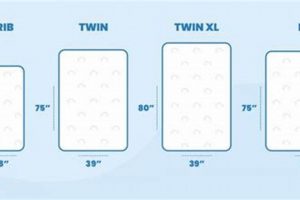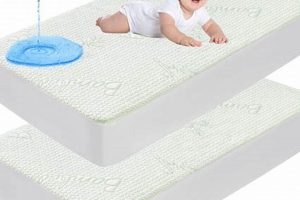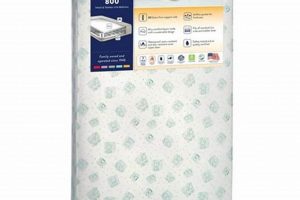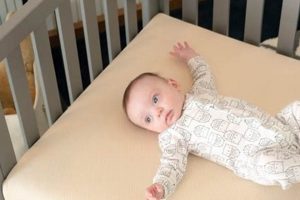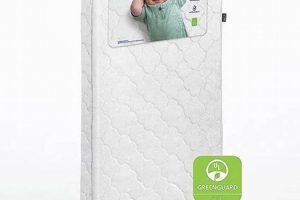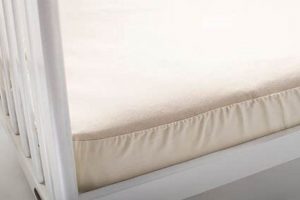A smaller sleep surface specifically designed to fit compact cribs is a crucial element for infant care. These products provide a safe and comfortable area for newborns and young babies in environments where space is limited. Selecting an appropriate model is vital to ensure infant well-being during sleep.
The selection of such a product is paramount for maintaining a secure sleeping environment in smaller nurseries or shared living spaces. Its reduced dimensions offer practicality without compromising infant comfort. Historically, the need for space-saving solutions in urban environments and smaller homes has driven the demand and improvement of these products, emphasizing safety standards and material quality.
The subsequent discussion will delve into the crucial factors for selecting a suitable model, focusing on dimensions, material composition, safety certifications, and considerations for long-term use.
Selecting the Ideal Sleep Surface for a Compact Crib
Choosing an appropriate sleep surface for a compact crib involves careful consideration of several factors to ensure infant safety and comfort. The following tips provide guidance on navigating the selection process.
Tip 1: Verify Exact Dimensions: Precisely measure the interior dimensions of the compact crib. The chosen surface should fit snugly, with no more than a two-finger gap between the edge of the surface and the crib frame. This prevents entrapment hazards.
Tip 2: Prioritize Firmness: Select a firm sleep surface. A firm surface reduces the risk of Sudden Infant Death Syndrome (SIDS). A surface should not conform significantly to the infant’s body weight.
Tip 3: Examine Material Composition: Opt for materials that are non-toxic and hypoallergenic. Look for certifications such as CertiPUR-US, which indicates that the foam has been tested for harmful chemicals and emissions.
Tip 4: Check for Waterproofing: A waterproof or water-resistant cover is essential for hygiene and ease of cleaning. Consider a removable, washable cover for added convenience.
Tip 5: Review Safety Standards: Ensure the product meets or exceeds current safety standards established by organizations such as the Consumer Product Safety Commission (CPSC). Check for compliance labels and certifications.
Tip 6: Consider Weight: A lighter weight surface simplifies sheet changes and makes it easier to remove the surface for cleaning. However, ensure that the weight does not compromise the firmness or durability.
Tip 7: Assess Durability: The sleep surface should maintain its shape and firmness over time. Read reviews and consider the warranty offered by the manufacturer to gauge the product’s longevity.
Following these guidelines will contribute to selecting a safe, comfortable, and durable sleep surface for the compact crib, promoting the infant’s well-being.
The subsequent section will explore the long-term maintenance and care of the chosen surface to maximize its lifespan and hygiene.
1. Dimensions
The dimensions of a sleep surface are critically important for a safe and functional “mini mattress for crib.” Precise measurements are paramount to prevent hazards within the confined space of a compact crib. The following points detail specific facets of dimensional considerations.
- Length and Width Conformance
Accurate length and width dimensions are essential for a snug fit. The surface must completely fill the interior of the crib, leaving no gaps exceeding the recommended safety limits (typically no more than two fingers’ width). A proper fit prevents an infant from becoming trapped between the surface and the crib sides, thus mitigating a serious suffocation risk. Variations, even minor ones, can compromise safety.
- Thickness and Height Considerations
The thickness of the surface should conform to the crib’s design. If it’s too thick, it could reduce the height of the crib sides, increasing the risk of an infant climbing out. If it’s too thin, it might not provide adequate support and comfort. The height must be consistent with safety guidelines and the structural integrity of the crib frame.
- Dimensional Stability Over Time
The dimensional stability of the surface material is critical. Over time and with use, some materials can compress or deform, altering the original dimensions. Such changes can create gaps or inconsistencies in support, compromising safety and comfort. Selecting high-quality, durable materials contributes to maintaining consistent dimensions throughout the product’s lifespan.
- Impact of Crib Design Variations
Crib dimensions can vary slightly between manufacturers and models. It’s crucial to measure the interior dimensions of the specific crib model being used, rather than relying on generic “mini crib” measurements. Discrepancies can lead to an unsafe fit. Always verify the manufacturer’s specifications and compare them against the surface’s dimensions.
The relationship between precise dimensions and the overall safety and functionality of a “mini mattress for crib” cannot be overstated. Failure to adhere to appropriate dimensional standards creates tangible risks for infant well-being. Therefore, diligent measurement and verification are crucial steps in selecting the right sleep surface for a compact crib environment.
2. Firmness
Firmness is a critical factor in the selection of a “mini mattress for crib,” directly impacting infant safety and well-being. An appropriate firmness level is essential for reducing the risk of suffocation and promoting healthy skeletal development.
- Role in SIDS Prevention
A firm sleep surface reduces the risk of Sudden Infant Death Syndrome (SIDS) by preventing the infant from sinking into the surface. A softer surface can conform to the infant’s face, potentially obstructing airways. Firmness supports an open airway, contributing to a safer sleep environment. For example, research consistently recommends firm surfaces to minimize SIDS risk.
- Impact on Skeletal Development
A firm surface provides proper support for the infant’s developing spine and skeletal structure. Soft surfaces can lead to uneven weight distribution and potentially affect posture. Consistent support contributes to healthy growth and alignment. Infants require a stable foundation during their formative months.
- Distinguishing Firmness Levels
Firmness is not synonymous with hardness. A suitable “mini mattress for crib” strikes a balance, providing support without excessive rigidity. The surface should offer resistance when pressed, yet not feel unyielding. Testing the surface by applying gentle pressure can help assess its suitability. A gradual, minimal indentation indicates adequate firmness.
- Material Composition and Firmness
The material composition significantly influences the firmness of a “mini mattress for crib.” High-density foam or innerspring designs often provide greater firmness than softer, less dense materials. Reviewing material specifications and certifications is essential to ensure the selected option aligns with established safety guidelines regarding firmness.
The interaction between firmness, material selection, and adherence to safety standards underscores its importance in creating a secure sleeping environment for infants. Prioritizing adequate firmness when selecting a “mini mattress for crib” is paramount to mitigate potential risks and support healthy development.
3. Materials
The selection of materials used in the construction of a “mini mattress for crib” directly impacts infant safety, comfort, and the overall lifespan of the product. The materials chosen influence factors such as breathability, toxicity, and resistance to allergens. For example, a mattress constructed with non-breathable materials can increase the risk of overheating, while the presence of volatile organic compounds (VOCs) in certain foams can pose health hazards to infants. Material selection is not simply an aesthetic choice; it is a critical determinant of a safe and healthy sleep environment.
The industry offers a range of materials, each with distinct properties. Natural materials such as organic cotton and wool are often favored for their breathability and hypoallergenic qualities. However, their cost can be prohibitive. Synthetic materials like polyester and polyurethane foam offer affordability but require careful scrutiny to ensure they meet safety standards regarding VOC emissions and flammability. For example, mattresses certified by organizations such as CertiPUR-US assure consumers that the foam has been tested for harmful chemicals. The choice of materials should also consider ease of cleaning and maintenance, as frequent accidents are common. A waterproof or water-resistant cover is essential for hygiene, preventing moisture from penetrating the inner layers and fostering bacterial growth.
In summary, the materials comprising a “mini mattress for crib” are foundational to its performance and safety. Careful consideration of breathability, toxicity, durability, and ease of maintenance is crucial. Certified materials and adherence to safety standards provide assurance that the product contributes to a healthy and secure sleep environment for the infant. The selection process must prioritize infant well-being over purely economic considerations.
4. Safety Certifications
The presence of safety certifications on a “mini mattress for crib” provides documented assurance that the product meets specific safety standards designed to protect infants. These certifications are not mere marketing claims; they represent independent verification by third-party organizations that the product has undergone rigorous testing and complies with established safety requirements. The cause is adherence to specific standards, and the effect is a reduction in potential hazards associated with infant sleep environments. Certifications address concerns such as flammability, chemical emissions, structural integrity, and absence of harmful substances. Without these certifications, the potential for exposure to unsafe materials or designs significantly increases, creating a direct threat to infant health and well-being. For example, a “mini mattress for crib” lacking a CertiPUR-US certification may contain foams with volatile organic compounds (VOCs) that can off-gas and pose respiratory risks to infants.
The practical significance of understanding safety certifications lies in the ability to make informed purchasing decisions. Parents and caregivers can leverage these certifications as a reliable indicator of product safety, filtering out options that do not meet acceptable standards. Certifications also empower consumers to hold manufacturers accountable for adhering to promised safety protocols. The absence of expected certifications should raise immediate concerns and prompt further investigation. For instance, a “mini mattress for crib” claiming to be hypoallergenic should possess a certification from a recognized allergy-focused organization, validating its claims and providing tangible proof of its suitability for sensitive infants. Actively seeking and understanding these certifications allows for a more proactive approach to ensuring infant safety.
In conclusion, safety certifications are an indispensable component of a safe “mini mattress for crib.” They represent a tangible commitment to safety, backed by independent verification and adherence to established standards. While challenges exist in navigating the complex landscape of certifications and interpreting their specific meanings, a proactive approach to understanding and prioritizing these certifications is essential for safeguarding infant health and well-being. Ignoring the presence or absence of relevant safety certifications introduces unnecessary and avoidable risks into the infant’s sleep environment.
5. Water Resistance
Water resistance is a critical feature for a “mini mattress for crib” due to the inevitability of spills, drool, and diaper leaks. The absence of water resistance results in moisture penetration into the inner layers of the sleep surface. This, in turn, fosters bacterial and mold growth, creating an unsanitary and potentially hazardous environment for the infant. For example, frequent exposure to moisture without adequate protection can lead to the proliferation of allergens, exacerbating respiratory issues and skin irritations. Therefore, water resistance is not merely a convenience; it is a fundamental element in maintaining a hygienic and safe sleep space. The cause (lack of water resistance) has a direct effect (bacterial growth, allergen proliferation) on the infant’s health.
The practical application of water resistance manifests in the ease of cleaning and maintenance. A surface with inherent water resistance allows for quick and efficient cleanup of spills, preventing the liquid from seeping into the mattress core. This minimizes the potential for lingering odors and staining. For instance, a “mini mattress for crib” with a waterproof cover can be wiped clean with a damp cloth after an accident, maintaining its integrity and prolonging its lifespan. Moreover, some models feature removable, washable covers, further simplifying the cleaning process and ensuring a consistently sanitary sleep environment. In real-world scenarios, this translates to less time spent on cleaning and more confidence in the hygiene of the infant’s sleep space.
In conclusion, water resistance is an indispensable attribute of a “mini mattress for crib.” It serves as a primary defense against moisture-related hazards, safeguarding infant health and simplifying maintenance. While challenges may arise in balancing water resistance with breathability, prioritizing this feature remains essential for creating a safe, hygienic, and durable sleep surface. Addressing this aspect directly contributes to the overall well-being of the infant by minimizing exposure to potential allergens and pathogens.
Frequently Asked Questions
The following questions address common concerns regarding the selection and use of a sleep surface for compact cribs.
Question 1: What are the standard dimensions for a mini mattress intended for use in a crib?
While dimensions may vary slightly, a common size is approximately 24 inches wide by 38 inches long. It is essential to measure the interior dimensions of the specific crib model to ensure a proper fit.
Question 2: How firm should a sleep surface be for a compact crib?
A firm surface is recommended to reduce the risk of Sudden Infant Death Syndrome (SIDS). The surface should not conform significantly to the infant’s body weight.
Question 3: What materials are considered safe for a mini mattress intended for a crib?
Non-toxic and hypoallergenic materials are preferred. Look for certifications such as CertiPUR-US, which indicates that the foam has been tested for harmful chemicals and emissions. Organic cotton and natural latex are also viable options.
Question 4: How frequently should a mini mattress used in a crib be replaced?
The lifespan depends on usage and material quality. Inspect the surface regularly for signs of wear, such as sagging or tears. Replace the surface if it no longer provides adequate support or exhibits signs of damage.
Question 5: What is the best method for cleaning a mini mattress designed for use in a crib?
Spot clean with a mild detergent and water. Avoid harsh chemicals or excessive moisture. A waterproof cover can simplify cleaning. Consult the manufacturer’s instructions for specific cleaning recommendations.
Question 6: Do all mini mattresses for cribs meet mandatory safety standards?
Not all models adhere to the same level of safety compliance. Verify that the product meets or exceeds safety standards established by organizations such as the Consumer Product Safety Commission (CPSC). Check for compliance labels and certifications.
Prioritizing safety and material quality is crucial when selecting a “mini mattress for crib.” The considerations outlined above provide guidance on making informed decisions.
The subsequent discussion will summarize key factors for choosing and maintaining a safe sleep environment for infants.
Concluding Considerations
This discussion has explored the critical attributes of a “mini mattress for crib,” underscoring the importance of dimensional accuracy, firmness, material safety, certifications, and water resistance in ensuring infant well-being. These factors are not optional enhancements but fundamental requirements for a safe and healthy sleep environment. The selection process demands a meticulous approach, prioritizing documented evidence of safety compliance and verifiable material specifications. The implementation of these guidelines directly mitigates potential risks associated with infant sleep, contributing to a reduction in preventable accidents and health complications.
Continued vigilance in monitoring evolving safety standards and technological advancements in material science is essential. Caregivers and manufacturers must maintain a steadfast commitment to infant safety, embracing innovation while upholding rigorous testing and verification protocols. The selection of a “mini mattress for crib” represents a critical investment in the health and well-being of the infant, necessitating informed decisions and a proactive approach to risk mitigation.


